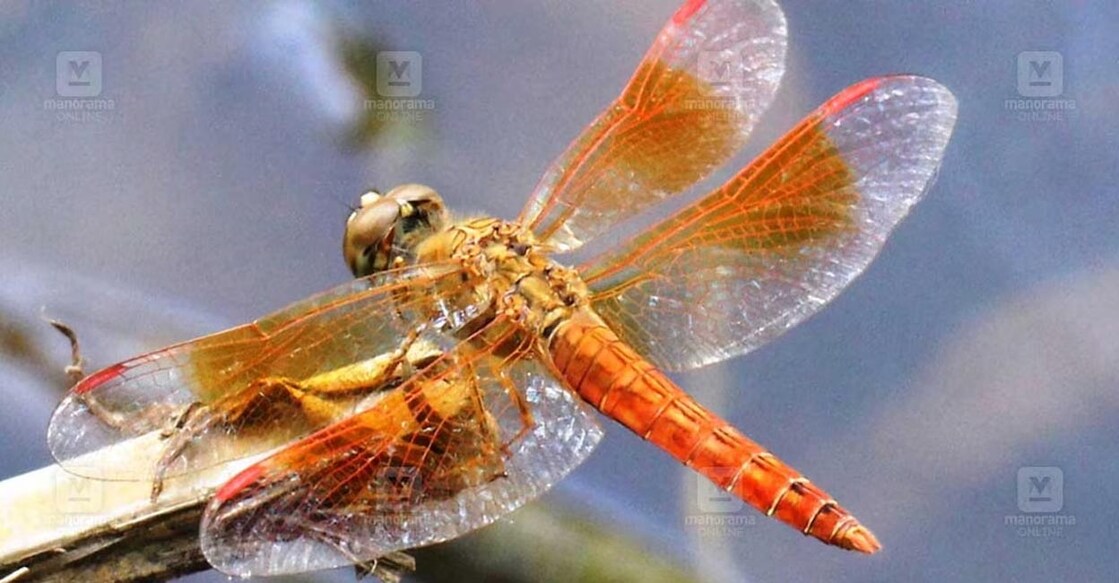Dragonfly species multiplying rapidly in Kerala not a good omen: Ecological expert

Mail This Article
If a high concentration of rare species of insects or birds is spotted in a particular region, that is a cause for concern.
Such a scenario is being witnessed in some parts of Kottayam– and this is polluting water bodies. Thirty species of dragonflies were spotted in a survey conducted at 14 places in a 60 km stretch on the banks of Vembanadu River. The survey was conducted by the Social Forestry Department and Tropical Institute of Ecological Sciences.
The unusual surge in the concentration of dragonflies is an indicator that water pollution is severe in Vembanadu Lake, Punnen Kurien, the top boss of the Tropical Institute of Ecological Sciences, which conducts studies on ecological issues, tells Manorama Online.
“Surveys to spot dragonflies are an annual feature in the Vembanadu and Meenachil rivers and the Konni forest division. One finding of these surveys was that a variety of dragonflies, called Changathithumbikal, was spotted in areas near polluted waterbodies. Most species of dragonflies lay eggs in freshwater bodies. But changathithumbi needs polluted waterbodies to lay eggs, and hence their presence is an indicator of polluted waterbodies nearby,” says Kurien.
In the case of the Meenachil River, Changathithumbi species were found in abundance at Eerattupetta, Pala, Kidangoor, and Kottayam, as well as Changanasserry and Vaikom, which are adjacent to Vembanadu. In areas of towns where waste dumping is rampant, the presence of this species was recorded.
The needle dragonfly and the black-winged dragonfly are found in forest areas, at high altitudes, and in land-locked areas. But this time, these were spotted in lakes in the Vaikom and Kumarakom areas.
Dragonflies are mainly of two types. Those with large bodies– the rock dragonflies, and those with thin bodies–the needle dragonflies. The dragonflies that are regularly seen around houses are the Swamithumbis (black and white ones). With the increase in pollution, their presence has decreased substantially.
Dragonflies that arrive during the Onam season are called Onam dragonflies and Thula dragonflies. These migratory dragonflies, which come from the northeastern parts of the country, arrive in Kerala in the Malayalam month of Thulam. They arrive in large groups and grow in numbers here after the reproductory process. Some of the species stay back, but most of them return, and the next batch arrives.
Conservation efforts
Kerala was an agrarian society for years. Its switch over to a consumerist society was all of a sudden. This brought about sweeping changes in people’s lifestyles. Pollution surged. Instead of consuming what we cultivate, the dictum changed to buy and consume. Everything became linked to a market-oriented culture.
The approach of moving ahead with scant regard for nature has undergone some changes recently. From the 1980s to 2010, exploitation of natural resources was rampant in the state. Environmental conservation became a priority globally after this. Many projects were conceived to conserve the environment and to check climate change, including Swachh Bharat and the Suchitwa Mission.
Efforts were initiated after realisation dawned that changes in our ecosystem and pollution were triggering health issues. We can take solace from the fact that though nature is being rampantly exploited at one end, efforts aimed at conservation are also taking place simultaneously.

Wildlife enters human terrain
There are two angles to the foray of wild animals to human-inhabited regions. After the Wildlife Protection Act came into force in 1972, hunting for wild animals declined. However, the population of wildlife species increased exponentially through reproduction. This is actually a good omen. But projects initiated in the guise of ecotourism are affecting wildlife and making sweeping changes. Wild animals are being lured from dense forests to its periphery so that tourists can have a glimpse of them. Deep inside the forests, where there are waterbodies, resorts are being set up rampantly. As such water bodies are being ruthlessly exploited, and water becomes scarce inside forests during summer. This forces wild animals to come to human habitats in search of water.
Mankind itself is responsible for the foray of wild animals to human settlements. By expanding humankind’s horizons to the dense jungles, the forest area shrinks. This resulted in scarce availability of food for wild animals forcing them to make forays into human settlements and wreak havoc on plantations. The elephants come in search of jackfruit. Human intervention has triggered all these. To end these reckless pursuits, we need to conduct proper studies before taking necessary action.
Kerala’s agricultural crops and lifestyle are suited for its mild climate, that existed through the length and breadth of this state. But everything related to that era has gone for a toss, including rain, mist and temperatures.

